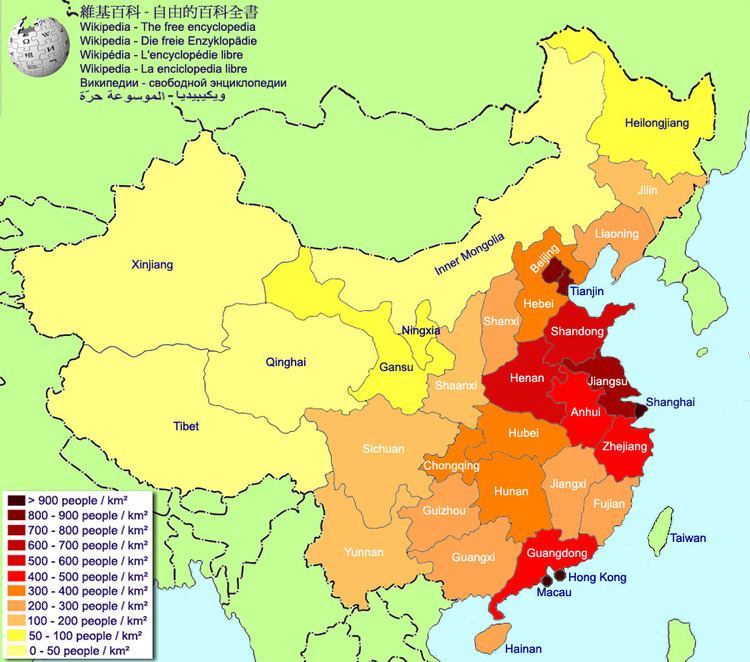 | ||
Social issues in China are varied and wide-ranging, and are a combined result of the Chinese economic reforms set in place in the late 1970s, China's political and cultural history, and an immense population. Because of the vast number of social problems that exist in China today (not at all exclusive to the following list), China's government has faced considerable difficulty in trying to remedy the issues. Many of these issues are exposed by the Chinese media, while subjects that may contain politically sensitive issues may be censored. Some academics hold that China's fragile social balance, combined with a bubble economy makes China an extremely unstable country, while others argue China's societal trends have created a balance to sustain itself.
Contents
Overview
According to Professor Jianrong, official statistics show the number of recorded incidents of mass unrest are "boiling ... to the point of explosion". They have risen from 8,709 in 1993 to more than 90,000 in each of 2007 through 2009. Reasons cited include an aggrieved class of dispossessed migrants and unemployed workers, a deep loss of faith in the system among many Chinese and a weakening in the traditional means of state control.
Professor Hu Xingdou of the Beijing University of Technology said corruption, state monopolies, the yawning wealth gap and the rising cost of housing, education and medical care all contribute significantly to unrest. He said land seizures and the widening wealth gap were the two top factors: Since the beginning of Deng Xiaoping's reforms in 1979, the disparity between the urban and rural populations has risen from 2.56:1 in 1978 to 3.33:1 in 2009. Urban income in 1978 was 343 yuan whilst rural income stood at 134 yuan; in 2009, the corresponding figures were 17,175 yuan and 5,153 yuan respectively. Despite the overall increase in urban income, unemployment, unpaid wages and police misconduct are sources of grievances.
Regional imbalances
Since the economic reforms in China began, income inequality has increased significantly. The Gini Coefficient, an income distribution gauge, has worsened from 0.3 back in 1986 to 0.42 in 2011,. Poverty researchers recognize anything above 0.4 as potentially socially destabilizing.
The growing wealth gap can be seen as a byproduct of China’s economic and social development policies. The adverse effects of having a widening inequity between the rich and the poor include social and political instability, discrimination in access to areas such as public health, education, pensions and unequal opportunities for the Chinese people. It is important to note that the inequality in income in China can also be seen as a rural-urban income gap especially with the widely criticized social development policy, the Hukou (household registration) System in place. Market income – mainly wages – has been the driving factor in shaping urban income inequality since the economic reforms in China while the widening rural-urban income gap is due to low salaries for employees and migrants in many companies coupled with rapidly growing profits for the management of State-owned enterprises, real estate developers and some private companies. The urban per capita net income stood at 17,175 yuan ($2,525) in 2009, in contrast to 5,153 yuan in the countryside, with the urban-to-rural income ratio being 3.33:1, according to figures from the National Bureau of Statistics.
The Hukou System has been long seen as an institutionalized source of inequality and disparity among the population and source of population control seen a deterrence factor for rural citizens to seek a higher standard of living in the cities as rural citizens will be denied access to urban housing and education for their children. It is also seen as a legacy of the dualistic economy, serving as a highly effective measure of limiting urban migration.
Population
Employment
Employment distribution has been an important issue for the Chinese Government ever since it began initiating reforms. Employment levels differs from region to region, with stronger concentrations of unemployment in the interior. That trend which has been stemmed in part from the efforts of the Chinese Government to make its SOEs (State Owned Enterprises), which had a redundancy rate at an estimated 25-30% in 1999, more efficient. on the other hand as of late 2011 the heavily industrialized coastal areas and cities are in fact experiencing an employment shortage due to the runaway growth of the economy. Guangdong province alone needs at least 1 million workers to cover the shortage.
